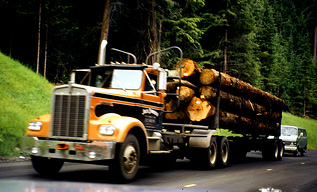by Karen Ripley, Forest Health Program Manager
Washington Department of Natural Resources
 Many small forest landowners’ have concerns that they have seen “Don’t Move Firewood!” bulletins, but frequently see log trucks carrying trees from eastern Washington forests to mills located in western Washington. Should you be concerned about insects like the western spruce budworm (or worse) that could be carried on these logs?
Many small forest landowners’ have concerns that they have seen “Don’t Move Firewood!” bulletins, but frequently see log trucks carrying trees from eastern Washington forests to mills located in western Washington. Should you be concerned about insects like the western spruce budworm (or worse) that could be carried on these logs?
Although the “Don’t Move Firewood!” national campaigns advocate using wood gathered within a 10 mile radius, and avoiding firewood movement more than 50 miles, the specific situation within Washington makes us comfortable moving logs from eastern Washington forests to western Washington mills.
First, transport of forest products that come from areas infested with hazardous pests that we know about is regulated. For example, you can’t transport Douglas-fir logs with any foliage or dirt adhering to them from northern California areas that have a disease called Sudden Oak Death. Any commercial log trucks coming out of the infested areas would have been inspected and treated to ensure that pest didn’t get moved. The general public that collects firewood may not know about those restrictions and could inadvertently break the rules and move known pests.
Second, firewood collectors often gather wood from dead urban trees. “Hey, my sister in Tacoma had a guy come take down a dead maple in the yard. She’ll give us the firewood if we clean it up. Want to go to Tacoma this weekend and get a trailer of free firewood?” Urban trees (especially dead trees located near international ports and commercial centers) are much more likely to harbor exotic pests than live trees that were cut in remote areas. Wood going from urban areas out to remote cabins or forested campgrounds is of much more concern than trees going the other direction.
Third, firewood often sits around. Even if pests didn’t kill the trees, the wood may be exposed to egg laying insects that have time to ride on firewood, mature, and disperse before the wood gets burned. Most mills keep excellent control of their inventories. Logs being delivered by trucks are debarked and processed relatively quickly, and the waste material is burned. Most of the serious bark beetles and tunneling insects wouldn’t have time to mature in the wood before it is processed.
Fourth, hauling material from eastern Washington to western Washington usually doesn’t take native forest pests across a distance they probably couldn’t already go on their own. The western spruce budworm, that is currently causing defoliation of Douglas-fir and grand fir over large areas of eastern Washington, is a good example. Although during late fall and winter a few tiny western spruce budworm caterpillars could be hidden among the bark of logs that are being transported, big concentrations of eggs are found on the needles and would not be transported with logs or bark. It’s also quite common to observe clouds of adult budworm moths that have been blown across major mountain passes from east to west in late summer. They lay eggs which grow into caterpillars that cause 1-2 years of defoliation, but fail to thrive and do not establish persistent populations. Something in western Washington (likely damp spring weather and competition from a different budworm species that’s more common in western Washington) suppresses them.
Aside from the western spruce budworm, most of the other wood pests found in eastern Washington are already in western Washington, so the few more Douglas-fir beetles or mountain pine beetles that get brought here and escape processing in the mill are just joining their brothers and sisters and competing with them for the same habitat.
There are many good reasons to operate mills and processing facilities to reduce hauling costs and provide more jobs close to areas where trees are harvested. There are also many reasons to avoid moving firewood that could harbor unknown pests. At this time, we are quite comfortable that the risks of moving pests across Washington on most commercial forestry products is low. Firewood is more risky than timber because of the longer distances, longer exposure time, urban to rural directions, and challenge of contacting users if a pest is detected.
An ongoing “thank you” to you for managing your forests to make them less susceptible to pests. By allowing the strongest trees to thrive, you reduce the chance that your land could be an easy target for native or exotic pests no matter how they’d arrive.
